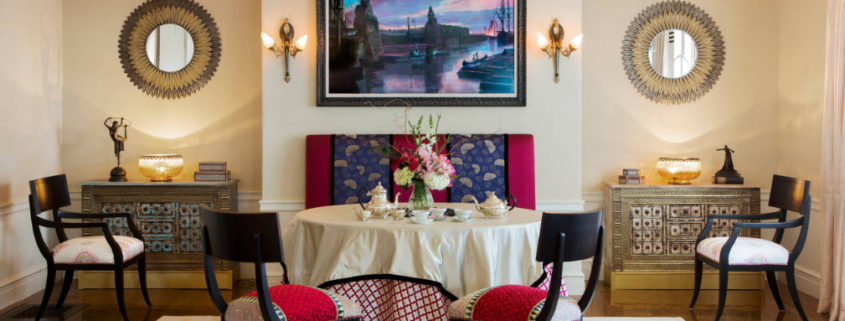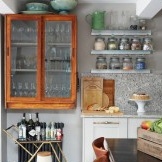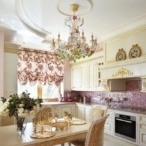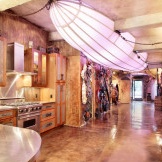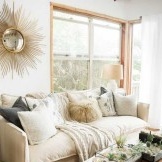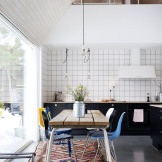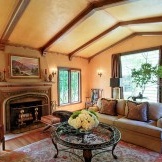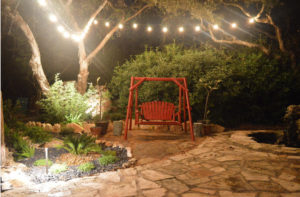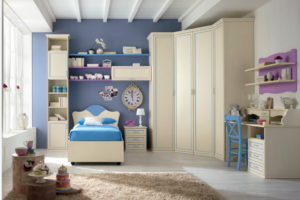Neoclassic in the interior: a modern look at traditions
If you always prefer a “middle ground”, if you are interested in a modern interpretation of centuries-old traditions, if you can admit the idea that sophisticated luxury can be performed in the spirit of our time, then the neoclassical style will certainly interest you. This style is able to organically fit both into a large family nest located in a spacious country house, and in the framework of a city apartment of a modern building. The classics’s enduring popularity is easily explained by its universality - it always stands in the middle of any stylistic extremes. The appearance of a neoclassical style is a completely natural phenomenon, as a reaction of modernity to the desire not only not to forget traditions, but also the desire to interpret them using modern materials and relevant design ideas. The neoclassical trend allowed the long-standing traditions in the design of living spaces to become more flexible, adapted to our realities. But at the same time, the style did not lose its sublime sophistication, the spirit of respectability and wealth, only becoming more universal and close to the modern owner of an apartment or private house.
The main features of the style
Neoclassical style is to the liking of established personalities, conservatives with a flexible approach to the possibilities of decorating their own home. Like everything else, neoclassic changes with time, mimics the ever-increasing pace of modern life. It is the ability to absorb relevant design ideas and adapt to modern materials that allows neoclassics to become more and more popular not only among designers, but also ordinary owners of houses and apartments who want to decorate their homes on their own, inspired by relevant design projects. Let us consider in more detail the main features of neoclassicism.
Natural color scheme
The decoration of rooms decorated in the neoclassical style is similar to the principles of choosing color solutions in classicism - mainly shades of natural origin. All shades of white (from boiling snow-white to milky), sand, ocher, beige, gray, brown, golden colors often serve as basic tones to create a general mood for the interior. Darker, colorful, sometimes even bright colors are used as unobtrusive accents that emphasize the geometry of the room, the orderliness of the situation.
The neoclassical style is somewhat eclectic, because against the background of classic decoration techniques (various stucco moldings, moldings and bas-reliefs) modern models of furniture, designer lighting fixtures or an original carpet can be located. But the color scheme of neoclassicism is quite conservative and does not accept a riot of colors, an abundance of prints that contradict each other in terms of palette or content of drawings. The overall picture of the interior in the neoclassical style is most often monochrome, presented in muted, pastel colors.
The rigor in creating the layout
The ideal option for a home in the neoclassical style is spacious, bright rooms with high ceilings and large windows. If there is also a large living room in such a dwelling, the design will turn out to be the most authentic. The spaciousness of the rooms is like a blank sheet for an artist, in spaces not constrained by square meters, you can build a perfectly symmetrical, strict, but at the same time comfortable atmosphere. It is the symmetry and ordering of all elements of the interior that is one of the distinguishing features of neoclassicism, as the followers of classical trends.Based on personal taste and design preferences, based on the severity of lines and shapes, you can create a completely unique, but at the same time “breathable” aristocratic interior. The advantage of neoclassic is that depending on your priorities and financial capabilities (and neoclassicist style designs are expensive), you can create any interpretation of the traditional style - from royal apartments to the laconic interior of a megalopolis resident.
When planning the arrangement of furniture in a room decorated in a neoclassical style, it is important to consider every detail. The furniture is arranged in accordance with the canonical principles of symmetry, sparseness and proportionality. For example, in the living room, the easiest way is to build symmetry around the fireplace - a mirror at eye level above the hearth, a pair of identical chairs near it, a coffee table in the center or a pair of small coasters (cabinets) of a similar design, arranged symmetrically upholstered furniture - all these techniques allow you to create some Mirror interior, introducing orderliness and conciseness into the overall picture of the room.
But the number of pieces of furniture and decor should not clutter up the space. The feeling of space and freedom is an integral part of the concept of neoclassicism. Moderation in the furniture used applies to the decoration of vertical surfaces. It is important to always remember the balance of functionality and decoration. The right proportions are the key to creating not only an authentic interior, but also an environment in which it will be convenient for households and their guests.
Features of Origin
Furniture in the neoclassical interior can be either solemnly decorated or presented by modern laconic models. In the first version, chairs and armchairs with bent legs, with oval seats and backs, carvings on the armrests and other structural elements are often found. Slightly elaborate, luxuriously decorated dressers, display cabinets with glass inserts (sometimes with stained-glass windows or images made by laser cutting), secretaries and other storage systems can complement quite modern models of upholstered furniture. Such eclecticism will look harmonious if metered in use.
Different national features can leave their mark on the execution of furniture in one style - neoclassicism. American neoclassic is more concise and functional, devoid of luxurious decor, and often even decorations. Such interiors look respectable, but quite simple, practical. Strict forms and lines, arranged in an ordered symmetry, make it possible to pay tribute to traditions without exposing luxury.
French neoclassicism can be called more “playful”, a little bizarre. Original bends, romantic moods, high canopies in the bedroom or stucco molding near the fireplace in the living room, candlesticks used not so much for their intended purpose, but as a decor or tribute to family traditions. Silver-plated or patina-backed furniture fittings, which are not an integral part of the image, but adorn it, are a frequent companion of the luxurious, but at the same time orderly atmosphere of French neoclassicism.
In the Russian version of the neoclassical style, echoes of the palace past may be present. Among modern finishing materials, a wardrobe with curved facades, pilasters with a capital, natural wood carving, and a crystal chandelier can harmoniously fit in. But all these elements, which have deep roots in classical traditions, have an aesthetic and essential connection with interior items made in accordance with current design ideas.
Natural motives
When creating an interior in the neoclassical style, colors and prints that are not annoying to the eye are used.No optical illusions and drawings that make you think, focus on the image - only simple and unobtrusive motifs in the design, close to nature. Wallpaper on the walls, textiles as a drapery of windows or upholstery of upholstered furniture, covers for sofa cushions - nowhere you will find strong contrasts or bright color combinations. Even in a print so popular for classics as a strip, all shades are selected carefully and make up a picture unobtrusive to the human eye.
In the upholstery of furniture or the drapery of window openings, quite realistic plant motifs are sometimes found. Floral theme can be used to create a carpet for a room in the neoclassical style. But all plant prints are laid out in an even cloth, not straying from the general image of the interior, becoming a harmonious integration, and not an accent element.
Love for decorating
For many of us, the classic interior is inevitably associated with rich window drapes. Luxurious fabrics that fall in large folds to the floor, hooks with tassels, elaborate clips, lambrequins and shuttlecocks - all these are components of classic, luxurious interiors. Neoclassic is more democratic in the issue of decoration. An ideal choice of drapery for window openings is an expensive high-quality fabric, flowing in even folds in the model of traditional straight curtains.
A similar picture develops with other decorative (but often quite functional) interior elements. They only hint at the luxury of historical classicism, often presenting in quite modern and laconic variations. Books, works of art, flowers in vases, table lamps with beautiful lampshades, wall sconces and simple-shaped mirrors in luxurious frames are the decorative elements of the interior that are customary for the modern homeowner to look at, which fulfill each of its functions.
Lighting devices, which are certainly functional elements of the interior, act as decor. According to the traditions of historical classicism, to equip the rooms with lighting fixtures, a luxurious, rich in decorative elements model of chandeliers, executed in several tiers, wall sconces, certainly located symmetrically, floor lamps with beautiful lampshades, is chosen. In the living room, bedroom and dining room, the royal chandelier that fills the room not only with artificial lighting, but also with the sparkle of glass or crystal, often becomes a key element in the design of the ceiling, around which there is a fanciful stucco molding of the outlet.
Examples of decoration in the neoclassical style
Living room
Neoclassicism in the living room is luxury and comfort, practicality in an attractive shell, the aristocracy of natural materials and the realm of symmetry. The living room, as the main room of the dwelling, becomes not just a multifunctional gathering center for the whole family, but also the face of an apartment or house, a business card that can set the tone for the entire dwelling and provide guests with the opportunity to experience the owners' character and lifestyle, their attitude to beauty and functionality.
The neoclassical living room is filled with functional luxury. The strict layout harmoniously coexists with the luxury of furniture upholstery, window drapery, the splendor of a chic chandelier and the thick pile of expensive carpet. At the same time, modern models of furniture, lighting fixtures and decorative elements are successfully integrated into the room, the decoration of which is based on historical classicism, but with dosing of decor (stucco moldings, balustrades, moldings and cornices).
Bedroom
Neoclassical style is great for a medium to large bedroom. The main element of the interior is a sleeping place, designed with due respect for the luxury of natural materials and the beauty of textiles made from noble raw materials, made in the spirit of modernity.Most often, a large, luxurious bed is complemented by two stands or table stands, on which or above which are located table lamps or wall sconces.
Most often, the bedroom, decorated in the style of neoclassicism, is a room in neutral, pastel colors. Against the background of a light finish on all surfaces, furniture made of dark wood looks especially advantageous. Noble chocolate shades, wenge color, may have a continuation in the design of the flooring, but most often the bed is located on the carpet of light shades.
Kitchen
A kitchen space designed in accordance with the concept of neoclassicism is as functional as a respectable room. The strict layout and the choice of natural materials on the one hand create an incredibly practical, ergonomic and comfortable environment, but on the other hand it always costs a penny to the owners. The interior of the kitchen, created in the neoclassical style, will be relevant for many years, your investments will pay off with a beautiful appearance of the decoration of the room and kitchen facades made of natural materials (or their spectacular counterparts) with a little elaborate furniture for modern furniture.
In neoclassical cuisine, as well as the style of historical classics, every detail is important. Not only the appearance of the facades of the kitchen set and surface finishes forms the image of the kitchen, but also the choice of material for countertops, models of chairs and a dining table or bar stools near the kitchen island or counter. Successful integration of modern household appliances into the kitchen space deserves no less attention. Unlike the classic areas in the design of kitchen spaces, household appliances are not covered by the facades of kitchen cabinets, they are not hidden from our eyes, but make up a harmonious combination of technical progress with traditional execution of furniture.
Canteen
The main attention in the design of the dining room is given to the creation of a dining group, the remaining elements of the interior become only the background or accompanying items of furniture and decor. It is difficult to imagine a neoclassical dining room without a spacious table made of natural solid wood with beautiful carved legs. But the chairs around the dining table can be different, even made in a modern style, but with the soft design of the seats and most often the backs. The picture of a respectable dining room is complemented by a luxurious chandelier located directly above the dining group.
Bathroom
The standard combined bathroom of "Khrushchev" or any other small-sized apartment is not for neoclassicism. The bathroom, in which it will be possible to reflect the concept of a modern interpretation of historical classicism, should be spacious and bright. After all, we will need to be able to not only provide a room for water procedures with all the necessary plumbing and storage systems, but also to show the beauty of natural finishing materials, the pretentiousness of bath and sink accessories and even the luxury of lighting fixtures.
Ancillary facilities
When decorating corridors, hallways and halls in the chosen style, neoclassicism, all the “responsibility” for creating an authentic design rests with the decoration of the room. Furniture in the corridors and spaces near the stairs is often absent altogether and all the attention of households and their guests is paid to the design of surfaces. When choosing neoclassic as the style of decorating an apartment, you can go home in two ways: create an accent design of auxiliary rooms that is colorful and even distinctive against the rest of the living space or a neutral design that will only be a bridge between the main rooms of the home.
When choosing the first option for the design of the corridor or entrance hall, as well as the space near the stairs (if available), the choice of flooring becomes an important point.The classic black and white “checkerboard” in glossy or matte finish becomes a cult element of the neoclassical interior. To support such a contrasting performance of the floors, it is necessary to withstand the decoration of the ceiling and walls in neutral light colors. Modest stucco molding on the ceiling, moldings or niches on the walls will be useful, in case the auxiliary room has high ceilings and a large area.

